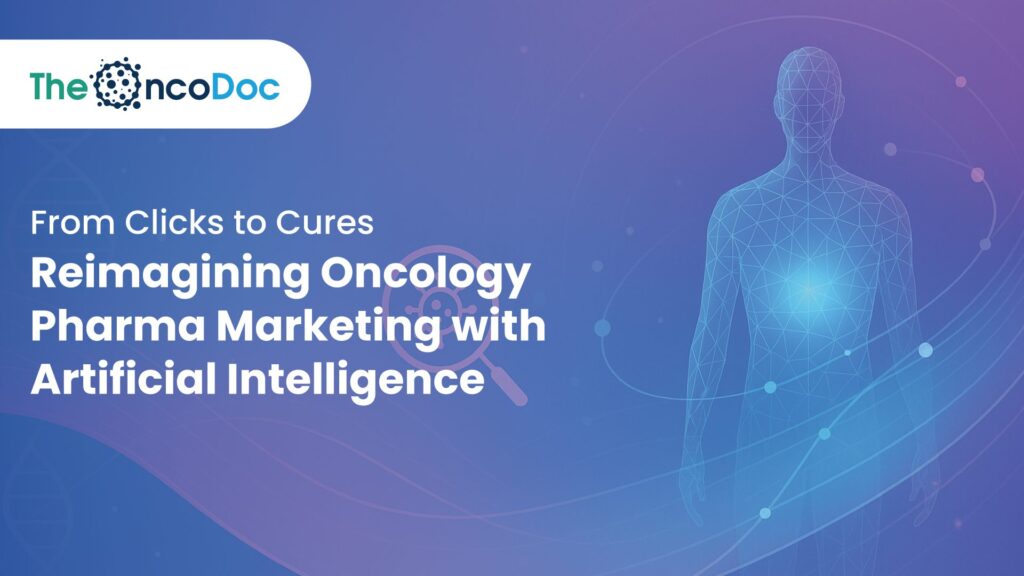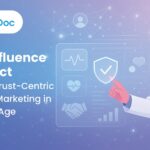Introduction: A New Era for Pharma in Oncology
The oncology landscape is undergoing a seismic shift. Historically, pharmaceutical marketing in this domain revolved around promoting treatments to oncologists, with little involvement in the upstream elements of the cancer care continuum. But in an era of digital acceleration and data abundance, this approach is evolving rapidly. The rise of artificial intelligence (AI) is not only changing how cancer is detected and treated but also how it is marketed.
In India, where over 70% of cancer cases are detected at advanced stages, the stakes are high.
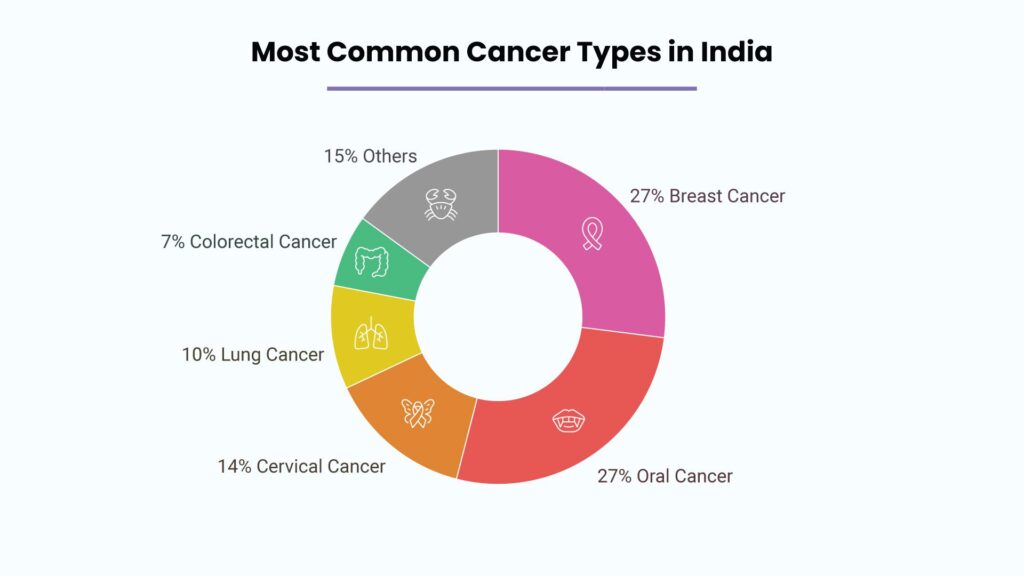
A combined approach involving pharma marketing, early diagnosis efforts, and AI-powered tools can change outcomes meaningfully. This article explores how pharmaceutical companies can leverage digital marketing, infused with artificial intelligence, to enhance early detection, drive timely referrals, and enable more personalized patient and physician engagement across India’s diverse healthcare ecosystem.
Section 1: Moving Upstream: Why Pharma Must Engage Earlier
Cancer care does not begin at chemotherapy; it begins with a symptom, often vague, misunderstood, or dismissed. While oncologists are crucial at later stages, the battle for lives is won earlier, in primary care clinics, pharmacies, and even homes.
Pharma marketers must shift their strategic focus to influence these early touchpoints:
- Primary Care Engagement: General physicians (GPs) in Tier 2 and Tier 3 cities often lack standardized tools or training to suspect and refer potential cancer cases early.
- Public Awareness: Myths, fear, and lack of knowledge continue to delay help-seeking behavior in rural and semi-urban populations.
- Screening Accessibility: Lack of nearby diagnostic centers and screening tools means symptoms often remain uninvestigated.
Digital marketing, enhanced by AI, can directly address these issues, not just by broadcasting messages, but by enabling intelligent, behavior-aware interventions.
Section 2: AI-Powered Public Health Education Campaigns
Predictive Audience Segmentation
AI enables pharma companies to predict who might benefit most from awareness interventions. Using geo-health data, Google search behavior, and regional cancer registries, marketers can identify high-burden zones and low-awareness clusters.
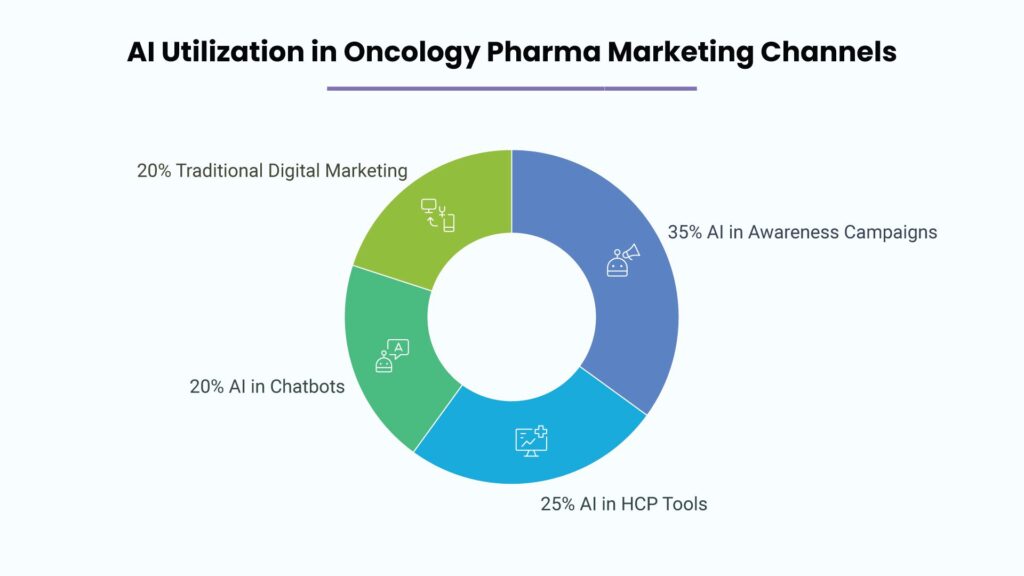
Example:
- AI models can analyze search trends like “blood in stool” or “persistent cough” in vernacular languages and geo-map regions for targeted outreach.
- NLP algorithms can crawl public social media posts for symptom mentions to identify “digital distress signals.”
Personalized Content Distribution
Once the target audience is identified, AI can help serve the right content to the right person at the right time:
- Use of recommender engines to push educational content (like videos on breast self-exams) to women aged 35+ in rural Karnataka via YouTube.
- AI-curated WhatsApp newsletters that adapt based on click behavior, e.g., if someone clicks on a cervical cancer video, the next message shares screening center locations.
This hyper-personalized approach moves beyond mass messaging into actionable nudging.
Section 3: Empowering Primary Physicians with Intelligent Tools
Primary care physicians are often the first and most influential touchpoint in cancer detection. Yet, many lack up-to-date knowledge of subtle or non-specific oncology red flags. Here’s how AI-powered marketing can bridge this gap:
1. Clinical Decision Support Tools
Pharma-sponsored apps or web portals can offer AI-backed symptom analysis tools for GPs:
- Input patient data (age, history, symptoms), and receive referral guidance based on trained models.
- Tools like IBM Watson and local NLP-powered engines can provide risk scoring, recommended diagnostics, and specialist matching.
2. Smart CME Integration
Medical education platforms such as Medtalks and Practo Academy can integrate AI to track each HCP’s knowledge gaps and auto-recommend CME modules accordingly.
For example:
- A doctor repeatedly skipping oncology modules might get nudged with a simplified “Cancer Suspicion Checklist” in regional languages.
- Performance analytics can help marketers refine module formats, identify top-engaged physicians, and plan in-person or webinar follow-ups.
Hyperlocal AI Strategies for India’s Fragmented Healthcare System
India’s healthcare landscape is not monolithic, it spans metros with multi-specialty hospitals to villages with one overworked GP and no diagnostics nearby. An effective AI-led marketing strategy must be hyperlocal, tailored to demographic, linguistic, and infrastructure diversity.
Geo-Targeted Campaign Customization
AI can enable real-time adjustments in campaign messaging and channel preference based on regional profiles:
- Example: In North-East India, where digital penetration is growing but literacy rates vary, AI might recommend video-first messaging in local dialects, while in Tier 1 cities like Bengaluru, email newsletters and LinkedIn HCP campaigns may perform better.
- Algorithm-Driven Localization: AI tools can pull from public health records, environmental exposure data, and lifestyle indicators to adapt risk-based messaging. For instance, tobacco-heavy districts in Uttar Pradesh can receive tailored oral cancer campaigns, emphasizing early dental checks and visual exams.
Language Intelligence for Deep Reach
Natural Language Processing (NLP) has matured to the point of reliably handling over 20 Indian languages and dialects. Pharma marketing teams can now:
- Auto-translate educational content using neural machine translation models while preserving medical accuracy.
- Detect cultural nuance in tone and phrasing to ensure empathy-driven outreach, e.g., using family-centric language for women’s cancers in rural belts.
Partnering with Local Micro-Influencers
AI-powered social listening tools can identify local social media influencers, even those with 500-2000 followers, who command trust in close-knit communities.
- Case in Point: A regional health vlogger in Odisha with 1500 followers might deliver more effective messaging on oral cancer than a national celebrity.
- AI algorithms can score potential influencers based on engagement authenticity, community sentiment, and topic relevance.
These hyperlocal strategies can transform pharma marketing from broad campaigns into community-rooted change agents.
Section 4: Conversational AI for Patient Self-Triage
Chatbots and virtual health assistants offer massive potential in early detection efforts, especially in low-literacy environments.
Vernacular Chatbots
AI-powered chatbots on WhatsApp or voice-based interfaces can:
- Ask simple symptom-based questions in languages like Hindi, Marathi, or Telugu.
- Offer basic risk insights (“You may need to consult a doctor for further investigation”) and geolocate nearby clinics.
- Link users directly to teleconsultations or screening appointments.
Example: A cervical cancer awareness bot can guide rural women through a self-assessment flow and refer them to the nearest screening van operating in the district.
Integration with Popular Platforms
Pharma can deploy these tools via existing high-engagement platforms:
- WhatsApp Business API for chatbot deployment
- Facebook Messenger for survivors’ Q&A formats
- Google Assistant for voice-based health advice in low-resource settings
Such platforms increase both accessibility and trust.
Section 5: Data-Driven Creative Optimization
Traditional marketing often stops at impressions and clicks. AI allows for dynamic content optimization that adjusts messaging in real-time based on behavioral data.
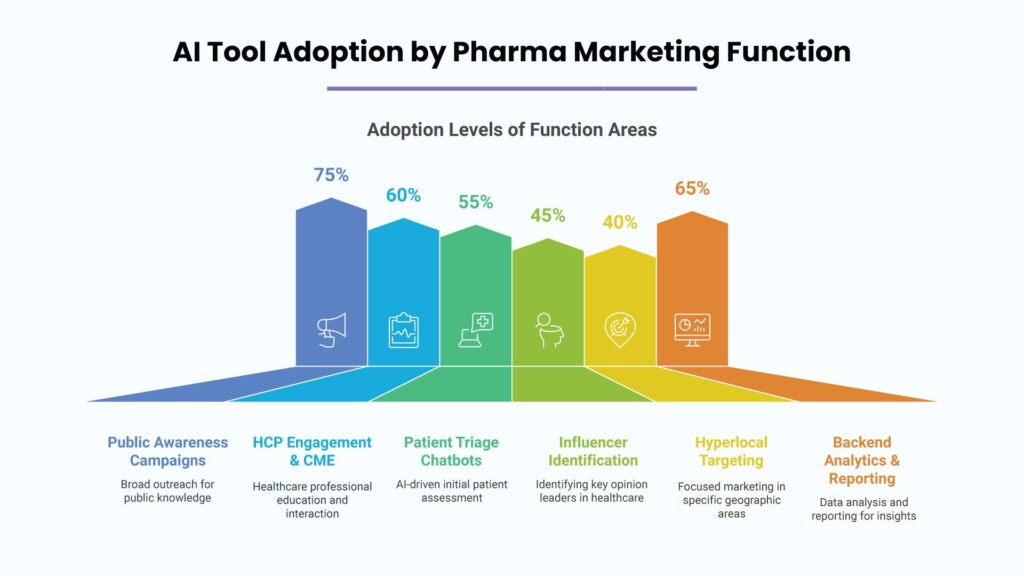
Key Tactics:
- A/B Testing at Scale: AI can automatically serve multiple ad creatives (e.g., survivor stories vs. clinical stats) and shift spend to high-performing variants.
- Scroll-Depth Analytics: Determine which content formats drive deeper engagement. Did viewers pause on a specific survivor quote or infographic?
- Engagement Heatmaps: Visualize which regions show high or low interaction with cancer education tools. This can inform on-ground event planning or new channel investments.
For example, if click-through rates on breast cancer content in Jharkhand are low, but WhatsApp engagement is high, future campaigns can prioritize voice notes and group shares over traditional banner ads.
AI and Gamification: Nudging Preventive Behavior
Traditional awareness tools, pamphlets, static ads, often fail to activate behavioral change. With AI, gamification can take center stage to improve engagement in a low-pressure, high-retention manner.
Health Quizzes and Risk Calculators
Gamified formats like “Could This Symptom Be Serious?” quizzes can be personalized using AI models:
- Input-based personalization: A user who reports fatigue and weight loss may be prompted with colorectal cancer info; someone reporting breast tenderness sees early detection steps for women’s cancers.
- Language Adaptive Content: Based on user’s location and app language setting, questions and explanations are dynamically localized.
Reward-Driven Engagement
To improve retention and completion of cancer education journeys, AI-powered systems can assign points, badges, or even small incentives.
- Example: An app linked to a cancer awareness campaign could allow users to earn mobile recharges for completing a screening eligibility assessment or referring others.
- Back-End Insights: AI tracks where users drop off in a quiz or video, helping marketers fine-tune friction points and information density.
This approach transforms passive education into interactive self-discovery, making learning about cancer less daunting and more memorable.
Section 6: Retargeting HCPs with Precision Nudges
Doctors often require multiple touches before changing referral behavior. AI can support a precision engagement strategy:
- Behavioral Scoring: Assign engagement scores to each HCP based on email opens, CME completion, click-throughs, and in-clinic tool usage.
- Automated Drip Campaigns: Use AI to sequence educational messages, e.g., case studies, quiz challenges, then referral pathway reminders.
- ChatGPT-powered HCP Assistants: Allow GPs to ask, “What should I suspect in a 45-year-old female with postmenopausal bleeding?” and get an instant, pharma-compliant answer.
This method moves beyond generic outreach to curated engagement journeys.
Section 7: Oncology Influencer Ecosystems: At Scale
Influencer marketing is evolving. In oncology, AI can help identify and empower micro-influencers for early detection narratives:
Survivor Advocacy Networks
AI-based sentiment analysis on YouTube, Instagram, and Facebook can identify cancer survivors who already have organic reach and trust.
- Pharma can partner with them to co-create content in a compliant, emotionally intelligent manner.
- Video narratives “How I detected breast cancer early” can be promoted using AI-enhanced engagement algorithms.
Doctor-Influencers and AI Filters
Doctors who maintain active social media profiles can become powerful agents of change. AI tools can:
- Filter which HCPs drive the most engagement per region
- Recommend what kind of content to co-create with them (e.g., Reels, Q&A sessions, Live webinars)
- Automatically suggest hashtags, timing, and formats based on local trend analysis
AI for Community Oncology Engagement: Beyond Social Media
While social media is powerful, many Indian communities still rely heavily on physical networks, schools, religious gatherings, local cooperatives, for trusted information exchange. AI can help pharma bridge both online and offline spheres.
Predictive Geo-Fencing for Event Placement
AI systems can analyze location data, footfall trends, and public health needs to suggest optimal sites for on-ground activations:
- Use Case: AI may identify that women aged 40+ in a Mumbai suburb frequently visit local mandals during weekday mornings. Pharma can plan breast cancer screening stalls nearby, timed with cultural gatherings.
Offline-to-Online Continuity
QR codes at local awareness events can lead to AI-personalized follow-ups:
- After scanning, users receive a tailored WhatsApp series in their language, reinforcing event takeaways and offering teleconsult booking.
- AI tools monitor click-through rates to gauge who is ready for deeper engagement, nudging them with additional resources or calls-to-action.
This AI-assisted continuum of care ensures that awareness doesn’t end with an event, it evolves into actionable journeys.
Section 8: AI-Enabled Backend Analytics and Impact Measurement
What gets measured gets improved. For AI-powered oncology marketing, backend analytics must track more than ad metrics, they must reflect health impact.
Advanced KPIs Include:
- % increase in first-time symptom search queries from target regions
- Change in referral rates from non-oncology HCPs post campaign
- Uptake of screening camps or telehealth links shared via campaign
- Pre-post campaign sentiment shifts on cancer conversations
AI-Powered Dashboards
Real-time dashboards can help pharma marketers:
- Visualize campaign ROI not just in clicks, but in early detection triggers
- Automate alerts when specific geographies underperform
- Track chatbot usage trends (common symptoms reported, conversation drop-offs)
Such insights guide future planning and help optimize spend per public health return.
Section 9: Regulatory, Ethical, and Data Privacy Considerations
With AI comes responsibility. Pharma marketers must navigate the use of personal health data and automated decisioning with caution.
Best Practices:
- Obtain explicit consent for chatbot-based symptom analysis.
- Avoid diagnostic overreach, tools should only recommend next steps, not conclude.
- Ensure all AI models used are explainable and auditable.
- Use de-identified datasets when targeting high-burden regions.
Working closely with regulatory authorities like the ICMR and ensuring ethical oversight is essential in building credibility.
Section 10: The Role of Policy and Partnerships
Scalability and sustainability require public-private collaboration. Pharma marketers must engage with:
- State Health Departments: For integration of AI tools into public health apps
- National Cancer Grid and NGOs: For co-branded awareness materials
- Ayushman Bharat and ABHA Digital Health IDs: For patient linkage, tracking, and follow-up nudges
Collaborations can amplify campaign reach, ensure access equity, and build systemic trust.
Conclusion: AI as an Amplifier of Intent
Digital tools can only amplify what marketers truly aim to achieve. In oncology, the goal must shift from mere brand preference to meaningful health outcomes. AI enables scale, personalization, and intelligence, but without strategic empathy, it’s just noise.
Pharma marketers must embrace a new charter:
- From product promotion to early problem detection
- From general messaging to precision behavior nudging
- From HCP engagement to population empowerment
The integration of AI into pharma marketing is not about replacing human effort but enhancing it, turning every touchpoint into a potential life-saving moment.
Cancer doesn’t wait. Neither should we.
The Oncodoc team is a group of passionate healthcare and marketing professionals dedicated to delivering accurate, engaging, and impactful content. With expertise across medical research, digital strategy, and clinical communication, the team focuses on empowering healthcare professionals and patients alike. Through evidence-based insights and innovative storytelling, Hidoc aims to bridge the gap between medicine and digital engagement, promoting wellness and informed decision-making.

